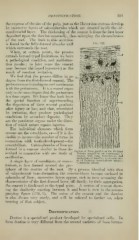Page 581 - My FlipBook
P. 581
DENTINIFICA TION. 591
the expense of the size of the pulp, just as the Haversian systems develop
by successive layers of calcospherules which are situated inside the cir-
cumferential layer. The thickening of the cement is from the first layer
deposited upon the dentine externally, thus enlarging the circumference
of the root. The limit to this accretion
is found in the fully-formed alveolar wall Fig.
which surrounds the root.
When, at certain points, the process
extends beyond typal limitations, we have
a pathological condition, and malforma-
tion results ; in later years the cement
may become thickened (exostosis) as the
result of constant irritation.
We find that the process differs in no
degree from the first-formed cement. The
pericementum is analogous and continuous
with the periosteum. It is a cement organ
only in the same degree that the periosteum
is a bone organ. We know that both have
the special function of superintending
the deposition of their several products
after injury or loss, and that, stimulated
by irritation, they produce pathological
conditions by secondary deposits. They
are the persistent organs under the direc-
tion of which nature repairs injuries.
The individual elements which form
cement are the osteoblasts, or—if it is de-
sirable to increase the number of terms in
connection with tooth-development—the
ccmentob/a.sts. C^alcospherules of lime are
formed in a manner similar to those de-
Section of Fang parallel to the Dentinal
scribed in connection with our study of Tubules f magnified .'SOO diameters): 1,
cement, with large bone-lacunse and
ossification.
indications of lamella
; 2, granular lay-
A single layer of osteoblasts, or cemen- er of Purkinje (interglobular spaces;;
o, dentinal tubules.
fohfriMx, is first formed around the per-
iphery of the dentine of the root. By a process identical with that
of subperiosteal bone-formation, the cementoblasts become enclosed in
spherules of lime ; successive layers appear, each in turn assuming the
characteristics of the first-formed layer, till finally, by their aggregation,
the cement is thickened to the typal point. A section of cement show-
ing the similarity existing between it and bone is seen in the accom-
panying figure (329, 1). The union of the cement and the dentine
is also shown very nicely, and will be referred to farther on, when
treating of that subject.
Dentinification.
Dentine is a specialized product developed by specialized cells. In
form dentine is very different from the several varieties of bone hereto-


